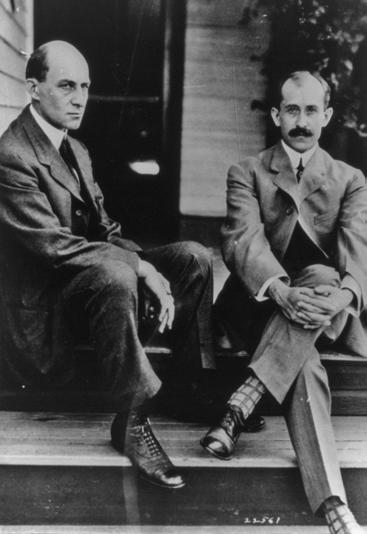
Wilbur and Orville, along with their surviving siblings (two older brothers and one younger sister), had parents who encouraged their love of science. Their mother, Susan, had studied mathematics in college. She taught her children to draw plans and to think through experiments. Their father, Milton, was a church official who traveled a great deal. He brought home presents that stimulated their interests.
Wilbur and Orville long remembered their favorite gift. It was a toy similar to today’s helicopter. It was made from cork, bamboo, and tissue paper. The brothers called it “the bat.” It was powered by two rubber bands attached to two propellers. It began their fascination with “flying machines.”
Through their teenage years, a variety of projects kept the boys’ interest. They were good at fixing and building things. Orville tried his hand at making and selling kites. He and Wilbur built a lathe together.
After working together on building a large printing press, the brothers decided to publish a weekly newspaper in the spring of 1889. Orville was the publisher, and Wilbur was the editor. In a short time, the West Side News turned into a daily newspaper with a new name, The Evening Item. Before long, though, Orville discovered another interest: bicycles.
Bicycles were popular in America in the mid-1890s. The brothers opened a series of four bicycle shops in Dayton. From them, they sold and repaired bicycles. Each shop was larger than the one that came before it. In 1896, the Wright brothers started building their own brands of bicycles—the Van Cleve and the St. Clair—with parts they manufactured themselves.
This story is from the November/December 2023 edition of Cobblestone American History Magazine for Kids.
Start your 7-day Magzter GOLD free trial to access thousands of curated premium stories, and 9,000+ magazines and newspapers.
Already a subscriber ? Sign In
This story is from the November/December 2023 edition of Cobblestone American History Magazine for Kids.
Start your 7-day Magzter GOLD free trial to access thousands of curated premium stories, and 9,000+ magazines and newspapers.
Already a subscriber? Sign In

Putting the Pieces Together
Americans needed to begin to put the past behind them, come together, and plan for the future in the spring of 1865. But Abraham Lincoln, the man best equipped to lead them and who had hoped to restore the country as smoothly and peacefully as possible, had been assassinated.

LAST SHOTS
The last Confederate forces in the Civil War didn’t surrender in the spring of 1865 or on a battlefield.

AND IN OTHER 1865 NEWS
A group of African Americans stop at the White House’s annual public reception on January 1, where they shake hands with President Abraham Lincoln.

A Plot to Kill President the
For several months, actor John Wilkes Booth’s band of conspirators had plotted to capture President Abraham Lincoln and hold him hostage in exchange for Confederate prisoners.

Let the Thing Be Pressed
In June 1864, Union Lieutenant General Ulysses S. Grant began a nearly 10-month campaign in Virginia.

HEALING THE NATION
President Abraham Lincoln took the oath of office for the second time on March 4, 1865.

A Helping Hand
The spring season is hard in any agricultural society. Plants and animals are too small to eat.

WAR SHERMAN-STYLE
As far as Union Major General William T. Sherman was concerned, the Civil War had gone on long enough.

PEACE TALKS
The fall of Fort Fisher made clear that the Confederacy’s days were numbered. Southerners were tired and hungry.

FORT FISHER'S FALL
Outnumbered Confederate soldiers inside Fort Fisher were unable to withstand the approach of Union troops by land and the constant Union naval bombardment from the sea.